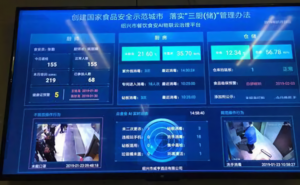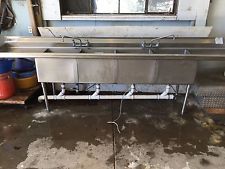Emily Hopkins of the Indy Star writes that at Indiana-based Rose Acre’s North Carolina farm, 3 million chickens produce about 2.3 million eggs every day, apparently under the watchful eye of a U.S. Department of Agriculture grader.
 That grader is supposed to be at the farm every day. Which raises a question: Why did it take an outbreak of Salmonella, one that sickened 23 people in nine states, to alert officials to problems at the farm?
That grader is supposed to be at the farm every day. Which raises a question: Why did it take an outbreak of Salmonella, one that sickened 23 people in nine states, to alert officials to problems at the farm?
A USDA spokeswoman acknowledged to IndyStar that a typical day for a grader involves checking a facility’s equipment prior to that day’s operation. It’s at this point that any observed issues are addressed. After that, the grader will enter the grading booth to inspect eggs during the processing day.
“In this instance, our grader(s) did not observe issues that would have triggered a report to FDA inspectors,” the spokeswoman said via email.
But the USDA didn’t specifically address IndyStar’s question about whether a grader should have observed those issues.
According to an egg grading manual published by the USDA, graders must “continually monitor product handling and general condition of equipment, and housekeeping throughout the (egg processing) facility” and ‘identify sanitation problems requiring corrective action.”
That might have applied to the Rose Acre Farm, where many of the FDA violations were made in the egg processing building.
For example, FDA inspectors who visited the farm after the Salmonella outbreak foundthat the procedure for cleaning the egg “orientor” was not being implemented, and employees were observed cutting corners while washing the eggs. Water from the “ceilings, pipes and down walls” was found dripping onto production equipment, and dried egg and shells were seen to have accumulated on the same areas over multiple days.
There were other violations, including excessive rodent activity, that were noted, but those were observed in the farm’s hen houses, which graders typically do not have access to.
After eggs are washed in the processing facility, graders check the eggs for cracks or other outside imperfections. They’ll also take a look inside the egg using a process called candling. Once the eggs are deemed up to USDA standards of quality, they receive a USDA seal.
 The value of the program, which is voluntary, is that it communicates to consumers that they are buying a product held to higher standards, according to Darrin Karcher, an extension poultry specialist at Purdue University.
The value of the program, which is voluntary, is that it communicates to consumers that they are buying a product held to higher standards, according to Darrin Karcher, an extension poultry specialist at Purdue University.
“It gives another layer of credibility to the consumer,” Karcher said.
Karcher, however, could not say whether in this particular case the USDA grader missed an opporutnity.
A grader’s day starts with a visual check of the processing plant before work begins, the USDA spokeswoman told IndyStar. If issues are observed, the grader is supposed to work with facility management to correct them before operations start.
“This is not a substitute for FDA’s more in-depth food safety regulatory examinations of an entire operation,” the spokeswoman said. “We take our responsibility very seriously and any time a significant issue is identified, USDA graders flag it for FDA through a formal process to ensure their regulatory inspectors are informed in a timely manner.”
This is one of the largest egg recalls since 2010, when 500 million eggs from an Iowa producer were recalled, and nearly 2,000 illnesses caused by Salmonella were reported. That outbreak spurred the FDA and USDA to issue a memorandum of understanding outlining information sharing priorities. The MOU authorizes USDA graders to withhold the seal if they believe that a facility is in violation of food safety rules or if the product poses a risk.
After the FDA linked the pathogen back to Rose Acres’s North Carolina farm, the company issued a voluntary recall of more than 206 million eggs, out of “an abundance of caution.”
Audits and inspections are never enough: A critique to enhance food safety
30.aug.12
Food Control
D.A. Powell, S. Erdozain, C. Dodd, R. Costa, K. Morley, B.J. Chapman
http://www.sciencedirect.com/science/article/pii/S0956713512004409?v=s5
Internal and external food safety audits are conducted to assess the safety and quality of food including on-farm production, manufacturing practices, sanitation, and hygiene. Some auditors are direct stakeholders that are employed by food establishments to conduct internal audits, while other auditors may represent the interests of a second-party purchaser or a third-party auditing agency. Some buyers conduct their own audits or additional testing, while some buyers trust the results of third-party audits or inspections. Third-party auditors, however, use various food safety audit standards and most do not have a vested interest in the products being sold. Audits are conducted under a proprietary standard, while food safety inspections are generally conducted within a legal framework. There have been many foodborne illness outbreaks linked to food processors that have passed third-party audits and inspections, raising questions about the utility of both. Supporters argue third-party audits are a way to ensure food safety in an era of dwindling economic resources. Critics contend that while external audits and inspections can be a valuable tool to help ensure safe food, such activities represent only a snapshot in time. This paper identifies limitations of food safety inspections and audits and provides recommendations for strengthening the system, based on developing a strong food safety culture, including risk-based verification steps, throughout the food safety system.
 According to the report, a camera-based system currently being piloted in the Zhejiang city of Shaoxing automatically recognizes “poor [sanitation] habits” and alerts managers to offending workers via a mobile app. It’s reportedly the fruit of a six-year project — Sunshine Kitchen — that seeks to bring transparency to food preparation in catering, hotels, school cafeterias, and restaurants.
According to the report, a camera-based system currently being piloted in the Zhejiang city of Shaoxing automatically recognizes “poor [sanitation] habits” and alerts managers to offending workers via a mobile app. It’s reportedly the fruit of a six-year project — Sunshine Kitchen — that seeks to bring transparency to food preparation in catering, hotels, school cafeterias, and restaurants. It’s not the first time AI has been applied to food safety.
It’s not the first time AI has been applied to food safety.









